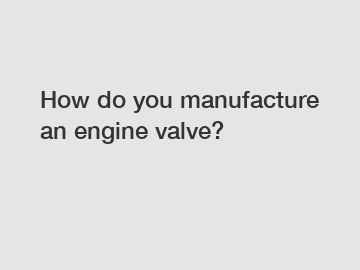How do you manufacture an engine valve?
Google Hot Topics: How do you manufacture an engine valve?
Manufacturing an engine valve is a complex process that requires precision engineering and careful attention to detail. But how exactly is an engine valve manufactured? In this article, we will delve into the step-by-step process of manufacturing an engine valve, discussing the various techniques and materials used.
1. Designing the Valve:

The first step in manufacturing an engine valve is designing it using Computer-Aided Design (CAD) software. Engineers consider factors like valve dimensions, material selection, and performance requirements to create an optimal design. The valve's shape, size, and configuration may vary depending on the intended application, such as passenger vehicles, high-performance sports cars, or heavy-duty industrial engines.
2. Material Selection:
Choosing the right material for an engine valve is crucial for ensuring durability, heat resistance, and wear resistance. Common materials used for engine valves include stainless steel, titanium, and various alloys. Each material has its advantages and limitations, such as cost, weight, and temperature resistance. Manufacturers carefully analyze these factors to determine the best material for the valve's intended application.
3. Forging or Casting:
Once the valve design and material selection are finalized, the manufacturing process begins. One common method is forging, where a solid piece of material is heated and shaped using a die. Forging enhances the metal's internal structure, making it stronger and more resistant to fatigue. Another method is casting, where molten metal is poured into a mold and allowed to solidify. Casting allows for intricate designs and is often used for valves with complex shapes.
4. Machining and Heat Treatment:
After forging or casting, the valve undergoes machining processes to refine its shape and dimensions. Computer Numerical Control (CNC) machines precisely remove excess material and create valve features, such as the valve head and stem. Following machining, the valve undergoes heat treatment processes like quenching and tempering to improve its mechanical properties and prevent deformation under high temperatures and stresses.
5. Surface Treatment:
To enhance the valve's durability, manufacturers apply surface treatments. One common technique is nitriding, where the valve is exposed to a nitrogen-rich environment, forming a hard nitride layer on the surface. This layer improves wear resistance and reduces friction. Other surface treatments include chrome plating and titanium nitride coating, depending on the desired characteristics and application.
6. Quality Control and Testing:
Before the valves are ready for installation, they undergo rigorous quality control measures. Manufacturers employ various testing methods, such as dimensional inspections, hardness tests, and material analysis, to ensure that the valves meet strict specifications. Additionally, valves are subjected to endurance tests, simulating real-world operating conditions, to ensure reliability and longevity.
Manufacturing an engine valve requires a combination of advanced engineering techniques, precise machining, and stringent quality control measures. The choice of materials, the forging or casting process, and the various treatments applied all contribute to creating a high-quality valve that can withstand the demands of an engine's operation.
In conclusion, the manufacturing process of an engine valve involves designing, material selection, forging or casting, machining, heat treatment, surface treatment, and rigorous quality control. By following these steps and employing advanced technologies, manufacturers can produce reliable and efficient engine valves that are capable of withstanding the harsh conditions of an engine's operation. So, the next time you start your car or experience the power of an engine, remember the intricate process involved in manufacturing one of its vital components – the engine valve.
For more information, please visit Motorcycle Engine Valve, high performance engine valves, Engine Valves 12575354.


